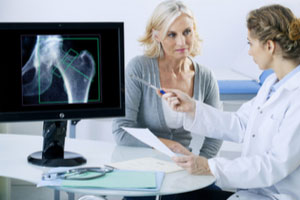Osteoporosis And Bone Health

In all likelihood, you’ve seen award-winning actress Blythe Danner on television discussing her osteoporosis diagnosis. If you have, you’ve heard her revelation that she is one of nearly 10 million Americans with the disease. And still, though you’ve heard it, you may not be aware of hows and whys of the disease and what can be done to aid in the fight against osteoporosis.
Defining Osteoporosis
Osteoporosis is a disease which causes bones to weaken and become brittle over time. This brittle state results in osteoporosis related fractures often in the hips, spine, or wrists. These injuries then leave sufferers with chronic pain, as well as loss of independence and mobility. The body is constantly losing and replacing living tissue, include bone. With osteoporosis, bone regeneration cannot keep up with loss. Bone loss gets greater with age, making older people more likely to get osteoporosis.
The Who of Osteoporosis
Osteoporosis is more common in Caucasian and Asian women, though it can and does affect both men and women of every race. Most sufferers are over the age of 50. Once reaching the age of 50, women and men are more likely to suffer fractures, women at a rate of one out of two and men at a rate of one out of five. Once individuals break one bone, others often follow in the future.
Age and gender, as well as a history of broken bones are obviously factors in getting osteoporosis, but there are more. These include: family history of osteoporosis (parents with hip fractures); early menopause; other conditions like rheumatoid arthritis, lung problems, diabetes, thyroid issues, and Parkinson’s disease; lack of exercise; medication use including steroids, seizure and heartburn medications, and breast and prostate cancer prescriptions; lack of calcium and vitamin D; diet low in vegetables and fruits; too little exercise; smoking; too thin; or the intake of too much protein, caffeine, alcohol, or sodium in your diet. Should any of these situations or conditions be true, there is no guarantee you will get the disease, but you should work toward staying healthy and keeping your bones strong.
Improving Your Bone Health
Yes, you can make lifestyle changes, along with adding medications to reduce the chance of fractures and enhance your bone health. First up, a visit to your physician is in order. He or she can gauge the health of your bones though a review of your medical history and a thorough exam.
Your doctor may also recommend a bone density test, DEXA (dual-energy x-ray absorptiometry). This test can help determine if your bones are healthy and normal, whether you have a proclivity to osteoporosis, or if you already have the disease. The procedure is simple for you, easy to perform, and only administers a very low level of radiation.
In most cases, your doctor will recommend a bone density test if you are over the age 50 and have broken a bone, are experiencing back pain, height loss of 0.5 inch in a single year or an overall loss of 1.5 inches from your original adult height. If there are no signs or symptoms of osteoporosis, your physician will advocate regular bone density testing starting at 65 years of age for women and age 70 for men. If you have already been diagnosed and are on medication to treat your osteoporosis, your doctor will advise you to have a bone density test every year or two to help you maintain optimal bone health.
